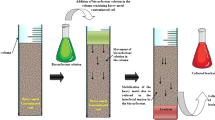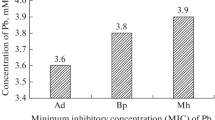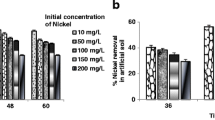Abstract
Heavy metal contamination in soil due to rapid industrialization has imparted a severe threat to the terrestrial ecosystem. Mining activity has perturbed the fertility and increased the heavy metal concentration in soil. Here we explore an inexpensive and environmentally friendly tool, biosurfactant to restore edaphic factors. Here, we have synthetically prepared contaminated sandy soil and black cotton soil with zinc and investigated the potential of biosurfactants in decontaminating zinc (Zn) from soil samples (sandy soil and black cotton soil). The biosurfactant (64 dynes/cm) was produced by bacillus subtilis MTCC 2423 on an unconventional substrate (20% distillery spent wash) and used as a tool to decontaminate zinc (heavy metal) from soil. The column experimental study was performed to evaluate the heavy metal removal efficiency of the biosurfactant. Statistical tool, Box-Behnken design (BBD) with an artificial neural network linked genetic algorithm (ANN-GA) was adopted to optimize the three independent variables viz., pH, biosurfactant concentration (%), and heavy metal (Zn) concentration. Results reveal that the decontamination efficiency of biosurfactant varied from soil to soil. Highest efficiency was observed in sandy soil compared to black cotton soil. Maximum efficiency of 89.11% was achieved with an optimal level of pH = 5, biosurfactant concentration = 100%, and Zn concentration = 2750 ppm in sandy soil. Whereas a maximum of 36.03% of zinc was removed in black cotton soil with pH, biosurfactant, and zinc concentrations of 7, 55%, and 500 ppm, respectively.






Similar content being viewed by others
References
Ayangbenro, A.S.; Babalola, O.O.: Genomic analysis of Bacillus cereus NWUAB01 and its heavy metal removal from polluted soil. Sci. Rep. 10, 1–12 (2020). https://doi.org/10.1038/s41598-020-75170-x
Chellaiah, E.R.: Cadmium (heavy metals) bioremediation by Pseudomonas aeruginosa: a minireview. Appl. Water Sci. 8, 1–10 (2018). https://doi.org/10.1007/s13201-018-0796-5
Kuppusamy, S.; Thavamani, P.; Venkateswarlu, K.; Lee, Y.B.; Naidu, R.; Megharaj, M.: Remediation approaches for polycyclic aromatic hydrocarbons (PAHs) contaminated soils: technological constraints, emerging trends and future directions. Chemosphere 168, 944–968 (2017). https://doi.org/10.1016/j.chemosphere.2016.10.115
Bharwana, S.; El Hadi, H.; Bilal Shakoor, M.; Ali, S.; Farid, M.; Ahsan Farooq, M.; Muhammad Tauqeer, H.; Iftikhar, U.; Hannan, F.; Aslam, B.S.: Heavy metal pollution, a global problem and its remediation by chemically enhanced phytoremediation: a review. J. Biodivers. Environ. Sci. 3, 12–20 (2013)
Hussain, S.; Khan, M.; Majid, T.; Sheikh, M.; Mumtaz, M.Z.; Chohan, T.A.; Shamim, S.; Liu, Y.: Zinc essentiality, toxicity, and its bacterial bioremediation: a comprehensive insight. Front. Microbiol. (2022). https://doi.org/10.3389/fmicb.2022.900740
Wuana, R.A.; Okieimen, F.E.: Heavy metals in contaminated soils: a review of sources, chemistry, risks and best available strategies for emediation. Int. Schol. Res. Not. 2011, 402647 (2011). https://doi.org/10.5402/2011/402647
Pagnanelli, F.; Esposito, A.; Toro, L.: Metal speciation and pH effect on Pb, Cu, Zn and Cd biosorption onto Sphaerotilus natans: Langmuir-type empirical model. Water Res. 37, 627–633 (2003)
Plum, L.M.; Rink, L.; Hajo, H.: The essential toxin: Impact of zinc on human health. Int. J. Environ. Res. Public Health. 7, 1342–1365 (2010). https://doi.org/10.3390/ijerph7041342
Femina Carolin, C.; Senthil Kumar, P.; Chitra, B.; Fetcia Jackulin, C.; Ramamurthy, R.: Stimulation of Bacillus sp. by lipopeptide biosurfactant for the degradation of aromatic amine 4-Chloroaniline. J. Hazard. Mater. 415, 125716 (2021). https://doi.org/10.1016/j.jhazmat.2021.125716
Tandogan, B.; UlusuHacettepe, N.N.: Effects of cadmium and zinc ions on purified lamb kidney cortex glucose-6-phosphate dehydrogenase activity. J. Enzyme Inhib. Med. Chem 21(2), 225–230 (2006). https://doi.org/10.1080/14756360500480533
Ashraf, S.; Ali, Q.; Zahir, Z.A.; Ashraf, S.; Asghar, H.N.: Phytoremediation: Environmentally sustainable way for reclamation of heavy metal polluted soils. Ecotoxicol. Environ. Saf. 174, 714–727 (2019). https://doi.org/10.1016/j.ecoenv.2019.02.068
Karthik, C.; Oves, M.; Thangabalu, R.; Sharma, R.; Santhosh, S.B.; Indra Arulselvi, P.: Cellulosimicrobium funkei-like enhances the growth of Phaseolus vulgaris by modulating oxidative damage under Chromium(VI) toxicity. J. Adv. Res. 7, 839–850 (2016). https://doi.org/10.1016/j.jare.2016.08.007
Wyszkowska, J.; Borowik, A.; Kucharski, M.; Kucharski, J.: Oddzia£ywanie kadmu, miedzi i cynku na roœliny, drobnoustroje i enzymy glebowe. J. Elem. 18, 769–796 (2013). https://doi.org/10.5601/jelem.2013.18.4.455
Etesami, H.: Bacterial mediated alleviation of heavy metal stress and decreased accumulation of metals in plant tissues: mechanisms and future prospects. Ecotoxicol. Environ. Saf. 147, 175–191 (2018). https://doi.org/10.1016/j.ecoenv.2017.08.032
He, Z.; Shentu, J.; Yang, X.; Baligar, V.C.; Zhang, T.; Stoffella, P.J.: Heavy metal contamination of soils: sources, indicators, and assessment. J. Environ. Indic. 9, 17–18 (2015)
Abdullah, N.; Yusof, N.; Lau, W.J.; Jaafar, J.; Ismail, A.F.: Recent trends of heavy metal removal from water/wastewater by membrane technologies. J. Ind. Eng. Chem. 76, 17–38 (2019). https://doi.org/10.1016/j.jiec.2019.03.029
Wu, J.; Xiao, C.; Wu, H.: Exploring electrode capture potential in different Cr-contaminated soils with enhanced electrolytes based on chemical fractionation. Sep. Purif. Technol. 197, 54–62 (2018). https://doi.org/10.1016/j.seppur.2017.12.047
Bailón-Salas, A.M.; Ordaz-Díaz, L.A.; Cháirez-Hernández, I.; Alvarado-de, P.A.; Proal-Nájera, J.B.: Lead and copper removal from groundwater by spherical agglomeration using a biosurfactant extracted from Yucca decipiens Trel. Chemosphere 207, 278–284 (2018). https://doi.org/10.1016/j.chemosphere.2018.05.103
Shoaib, A.; Akhtar, S.; Akhtar, N.: Copper tolerance, protein and catalytic activity in phytopathogenic fungus alternaria alternata. Glob. Nest J. 17, 664–672 (2015). https://doi.org/10.30955/gnj.001513
Kumar, V.; Dwivedi, S.K.: Hexavalent chromium reduction ability and bioremediation potential of Aspergillus flavus CR500 isolated from electroplating wastewater. Chemosphere 237, 124567 (2019). https://doi.org/10.1016/j.chemosphere.2019.124567
Anno, F.D.; Sansone, C.; Ianora, A.; Anno, A.D.: AC SC. Elsevier Ltd (2018)
Abou-Aly, H.E.; Youssef, A.M.; El-Meihy, R.M.; Tawfik, T.A.; El-Akshar, E.A.: Evaluation of heavy metals tolerant bacterial strains as antioxidant agents and plant growth promoters. Biocatal. Agric. Biotechnol. 19, 101110 (2019). https://doi.org/10.1016/j.bcab.2019.101110
Phulpoto, I.A.; Yu, Z.; Hu, B.; Wang, Y.; Ndayisenga, F.; Li, J.; Liang, H.; Qazi, M.A.: Production and characterization of surfactin-like biosurfactant produced by novel strain Bacillus nealsonii S2MT and it’s potential for oil contaminated soil remediation. Microb. Cell Fact. 19, 1–12 (2020). https://doi.org/10.1186/s12934-020-01402-4
Juwarkar, A.A.; Dubey, K.V.; Nair, A.; Singh, S.K.: Bioremediation of multi-metal contaminated soil using biosurfactant—a novel approach. Indian J. Microbiol. 48, 142–146 (2008). https://doi.org/10.1007/s12088-008-0014-5
Usman, M.M.: Application of biosurfactants in environmental biotechnology. Remediat. Oil Heavy Metal 3, 289–304 (2016). https://doi.org/10.3934/bioeng.2016.3.289
Karanth, N.G.K.; Deo, P.G.; Veenanadig, N.K.: Microbial production of biosurfactants and their importance. Curr. Sci. 77, 116–126 (1999)
Veenanadig, N.K.; Gowthaman, M.K.; Karanth, N.G.K.: Scale up studies for the production of biosurfactant in packed column bioreactor. Bioprocess Eng. Bioprocess Biosyst. Eng. 22, 95–99 (2000). https://doi.org/10.1007/s004490050017
Mnif, I.; Ghribi, D.: Microbial derived surface active compounds: properties and screening concept. World J. Microbiol. Biotechnol. 31, 1001–1020 (2015). https://doi.org/10.1007/s11274-015-1866-6
Lopes, C.S.C.; Teixeira, D.B.; Braz, B.F.; Santelli, R.E.; de Castilho, L.V.A.; Gomez, J.G.C.; Castro, P.V.R.; Seldin, L.; Freire, D.M.G.: Application of rhamnolipid surfactant for remediation of toxic metals of long- and short-term contamination sites. Int. J. Environ. Sci. Technol. 18, 575–588 (2021). https://doi.org/10.1007/s13762-020-02889-5
Devatha, N.A.J.C.P.: Degradation of triclosan from domestic wastewater by biosurfactant produced from Bacillus Licheniformis. Mol. Biotechnol. (2019). https://doi.org/10.1007/s12033-019-00193-3
Adi, V.K.; Jayalatha, N.A.: Restoration of physico-chemical properties of zinc contaminated soil by bacterial biosurfactant. Int. J. Curr. Trends Sci. Technol. (2017). https://doi.org/10.15520/ctst.v7i10.59
Diaz, M.A.; De Ranson, I.U.; Dorta, B.; Banat, I.M.; Blazquez, M.L.; Gonzalez, F.; Muñoz, J.A.; Ballester, A.: Metal removal from contaminated soils through bioleaching with oxidizing bacteria and rhamnolipid biosurfactants. Soil Sediment Contam. 24, 16–29 (2015). https://doi.org/10.1080/15320383.2014.907239
Suganthi, S.H.; Murshid, S.; Sriram, S.; Ramani, K.: Enhanced biodegradation of hydrocarbons in petroleum tank bottom oil sludge and characterization of biocatalysts and biosurfactants. J. Environ. Manag. 220, 87–95 (2018). https://doi.org/10.1016/j.jenvman.2018.04.120
Adi, V.K.; Savitri, B.K.: Utilization of spent wash for optimum production of biosurfactant using response surface methodology. J. Mater. Environ. Sci. 10(4), 298–304 (2019)
Hentati, D.; Chebbi, A.; Hadrich, F.; Frikha, I.; Rabanal, F.; Sayadi, S.; Manresa, A.; Chamkha, M.: Production, characterization and biotechnological potential of lipopeptide biosurfactants from a novel marine Bacillus stratosphericus strain FLU5. Ecotoxicol. Environ. Saf. 167, 441–449 (2019). https://doi.org/10.1016/j.ecoenv.2018.10.036
Gudiña, E.J.; Fernandes, E.C.; Rodrigues, A.I.; Teixeira, J.A.; Rodrigues, L.R.: Biosurfactant production by Bacillus subtilis using corn steep liquor as culture medium. Front. Microbiol. 6, 1–7 (2015). https://doi.org/10.3389/fmicb.2015.00059
Adamu, A.; Ijah, U.J.J.; Riskuwa, M.L.; Ismail, H.Y.; Ibrahim, U.B.: Isolation of biosurfactant producing bacteria from tannery effluents in Sokoto metropolis, Nigeria. Int. J. Innov. Sci. Eng. Technol. 2, 366–373 (2015)
Gong, G.; Zheng, Z.; Chen, H.; Yuan, C.; Wang, P.; Yao, L.; Yu, Z.: Enhanced production of surfactin by Bacillus subtilis E8 mutant obtained by ion beam implantation. Food Technol. Biotechnol. 47, 27–31 (2009)
Naik, N.M.; Jagadeesh, K.S.; Alagawadi, A.R.: Microbial decolorization of spentwash: a review. Indian J. Microbiol. 48, 41–48 (2008). https://doi.org/10.1007/s12088-008-0005-6
Dutta, K.; Dasu, V.V.; Hegde, K.: Development of medium and kinetic modeling for enhanced production of Cutinase from pseudomonas cepacia NRRL B-2320. Adv. Microbiol. 03, 479–489 (2013). https://doi.org/10.4236/aim.2013.36064
Kumar, S.; Pakshirajan, K.; Venkata Dasu, V.: Development of medium for enhanced production of glutaminase-free l-asparaginase from pectobacterium carotovorum MTCC 1428. Appl. Microbiol. Biotechnol. 84, 477–486 (2009). https://doi.org/10.1007/s00253-009-1973-0
Venkata Dasu, V.; Panda, T.: Optimization of microbiological parameters for enhanced griseofulvin production using response surface methodology. Bioprocess Eng. 22, 45–49 (2000). https://doi.org/10.1007/pl00009099
Prabhu, A.A.; Chityala, S.; Garg, Y.; Venkata Dasu, V.: Reverse micellar extraction of papain with cationic detergent based system: an optimization approach. Prep. Biochem. Biotechnol. 47, 236–244 (2017). https://doi.org/10.1080/10826068.2016.1201685
Yasin, Y.; Ahmad, F.B.H.; Ghaffari-Moghaddam, M.; Khajeh, M.: Application of a hybrid artificial neural network-genetic algorithm approach to optimize the lead ions removal from aqueous solutions using intercalated tartrate–Mg–Al layered double hydroxides. Environ. Nanotechnol. Monit. Manag. 1–2, 2–7 (2014). https://doi.org/10.1016/j.enmm.2014.03.001
Singh, P.; Patil, Y.; Rale, V.: Biosurfactant production: emerging trends and promising strategies. J. Appl. Microbiol. 126, 2–13 (2019). https://doi.org/10.1111/jam.14057
Gao, L.; Kano, N.; Sato, Y.; Li, C.; Zhang, S.; Imaizumi, H.: Behavior and distribution of heavy metals including rare earth elements, thorium, and uranium in sludge from industry water treatment plant and recovery method of metals by biosurfactants application. Bioinorg. Chem. Appl. (2012). https://doi.org/10.1155/2012/173819
Desai, K.M.; Survase, S.A.; Saudagar, P.S.; Lele, S.S.; Singhal, R.S.: Comparison of artificial neural network (ANN) and response surface methodology (RSM) in fermentation media optimization: case study of fermentative production of scleroglucan. Biochem. Eng. J. 41, 266–273 (2008). https://doi.org/10.1016/j.bej.2008.05.009
Khayet, M.; Cojocaru, C.: Artificial neural network modeling and optimization of desalination by air gap membrane distillation. Sep. Purif. Technol. 86, 171–182 (2012). https://doi.org/10.1016/j.seppur.2011.11.001
Ashish, A.; Prabhu, A.J.: Optimization of enzyme assisted improvement of polyphenols and free radical scavenging activity in red rice bran: a statistical and neural network based approach. Prep. Biochem. Biotechnol. 47(4), 397–405 (2017)
Jayalatha, N.A.; Devatha, C.P.: Experimental investigation for treating ibuprofen and triclosan by biosurfactant from domestic wastewater. J. Environ. Manag. 328, 116913 (2023). https://doi.org/10.1016/j.jenvman.2022.116913
Luna, J.M.; Rufino, R.D.; Sarubbo, L.A.: Biosurfactant from Candida sphaerica UCP0995 exhibiting heavy metal remediation properties. Process Saf. Environ. Prot. 102, 558–566 (2016). https://doi.org/10.1016/j.psep.2016.05.010
De Franҫa, Í.W.L.; Lima, A.P.; Lemos, J.A.M.; Lemos, C.G.F.; Melo, V.M.M.; De Sant’ana, H.B.; Gonҫalves, L.R.B.: Production of a biosurfactant by Bacillus subtilis ICA56 aiming bioremediation of impacted soils. Catal. Today. 255, 10–15 (2015). https://doi.org/10.1016/j.cattod.2015.01.046
Yang, Z.; Shi, W.; Yang, W.; Liang, L.; Yao, W.; Chai, L.; Gao, S.; Liao, Q.: Combination of bioleaching by gross bacterial biosurfactants and flocculation: a potential remediation for the heavy metal contaminated soils. Chemosphere 206, 83–91 (2018). https://doi.org/10.1016/j.chemosphere.2018.04.166
Grzywaczyk, A.; Smułek, W.; Smułek, G.; Ślachciński, M.; Kaczorek, E.: Application of natural surfactants for improving the leaching of zinc and copper from different soils. Environ. Technol. Innov. 24, 101926 (2021). https://doi.org/10.1016/j.eti.2021.101926
Kanmani, S.; Gandhimathi, R.: Assessment of heavy metal contamination in soil due to leachate migration from an open dumping site. Appl. Water Sci. 3, 193–205 (2013). https://doi.org/10.1007/s13201-012-0072-z
Sujata, B.R.; Khanapure, V.U.: Removal of heavy metals from the contaminated soil using soil washing technique with biosurfactant. Int. J. Eng. Res. 6, 366–372 (2017). https://doi.org/10.17577/ijertv6is070234
Esakku, S.; Palanivelu, K.; Joseph, K.: Assessment of heavy metals in a municipal solid waste dumpsite. Work. Sustain. Landfill Manag. 35, 139–145 (2003)
Tang, J.; He, J.; Xin, X.; Hu, H.; Liu, T.: Biosurfactants enhanced heavy metals removal from sludge in the electrokinetic treatment. Chem. Eng. J. (2017). https://doi.org/10.1016/j.cej.2017.12.010
Acknowledgements
The author wishes to thank the H.O.D Department of Civil Engineering, B.I.E.T. Davangere, for providing the laboratory facility to conduct the work. Also, the authors are thankful to Shri Laxmi Narayan Chemicals and Fertilizers Private Limited, Dharwad, for giving the AAS instrument facility for the analysis.
Author information
Authors and Affiliations
Corresponding author
Supplementary Information
Below is the link to the electronic supplementary material.
Rights and permissions
Springer Nature or its licensor (e.g. a society or other partner) holds exclusive rights to this article under a publishing agreement with the author(s) or other rightsholder(s); author self-archiving of the accepted manuscript version of this article is solely governed by the terms of such publishing agreement and applicable law.
About this article
Cite this article
Jayalatha, N.A., Prabhu, A. & Adi, V.K. Assessing the Potential of Biosurfactant Production by Bacillus subtilis MTCC 2423 to Remediate the Zinc-Contaminated Soil: A Process Optimization Approach. Arab J Sci Eng 49, 43–57 (2024). https://doi.org/10.1007/s13369-023-07938-y
Received:
Accepted:
Published:
Issue Date:
DOI: https://doi.org/10.1007/s13369-023-07938-y




